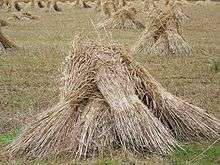Sheaf (agriculture)

A sheaf is a bundle of cereal plant stems bound together after harvesting, or reaping. The sheaves are bound using the stem material and are stacked together in a stook with the stems vertical and the seed heads aligned; this keeps the heads off the ground, allows the grain to dry, discourages vermin, makes the crop easier to pick up and is convenient for winnowing or threshing. Reaping is the cutting of grain or pulse for harvest, typically using a scythe or sickle. Grass for hay was also sheaved and stacked to dry in the field in this way but is now usually mechanically windrowed and baled.
The advent of mechanical harvesting has generally rendered the sheaf redundant in developed countries but remains in widespread use around the world. Wheat sheaves are sized for picking up and pitching onto a cart with the seed heads aligned using a traditional two-pronged pitchfork.
Traditional mowers using scythes and working as a team would cut a field of grain clockwise, starting from an outside edge and finishing in the middle. The action of scything left a windrow of cut stems to the left of the mower, and if cut skillfully, left the seed heads more or less aligned. These were then picked up and assembled into sheaves by following workers who tied the bundles using spare cut stems. These workers, or a separate following team, would then assemble the sheaves into stooks. The stooks would later be loaded onto a cart and taken to a barn in preparation for winnowing or threshing.
Heraldry
In heraldry a wheat sheaf is called a garb.[1]
See also
- Omer (unit), a Biblical measure of volume of grain.
References
- ↑ "garb" at Wiktionary. Retrieved 22 August 2012.